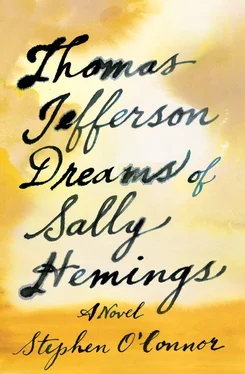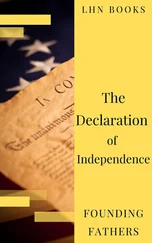— The Reverend Peter Fossett
“Once the Slave of Thomas Jefferson”
New York Sunday World
January 30, 1898
The movie once seemed it would never end, but now the actor who wore the copper-colored wig is wearing a skinlike skullcap: pink, freckled and crossed by cobwebs of white. A pinkish putty has been attached to his face, and it does look remarkably like aged flesh, though unnaturally inflexible. The putty and skullcap are good enough, though, that the actor is clearly portraying a man in his mid-eighties, possibly even his nineties — which strikes Thomas Jefferson as a respectable life span; to want to live longer would be to ask for more than one’s fair allotment, unseemly in a democracy where all are meant to be equal.
Thomas Jefferson finds himself strangely content as he watches the actor compose his character’s end. There is something geological in the swirl of white sheets on the bed, and there is a dawnlike luminescence in the death chamber, as if the actor were a mountain range catching the first silver beams of a sun returning after a long season of darkness, so that his death seems a new beginning.
There is, indeed, much beauty in this death. The aesthetic dimensions of every detail have been maximized: The hands on the sheets, for example, approach each other upon the axes of a tilted 125-degree angle — they approach but never touch. Within these hands is the potential for a clasp, but that potential will be eternally unrealized. Likewise, strength is latent in their musculature, but they are the quintessence of frailty. The actor’s half-closed eyes, granted a bluebird brilliance by the silver light, appear the most flawless visual organs imaginable, and yet the images projected onto their internal concavity can only be mere shadows, unaccompanied by answering projections within the mind. And those putty-covered lips are so clearly poised to pronounce a word— What is it? Freedom? Sorrow? Equality? I?
No one will ever know.
Yet the true beauty of this scene is not in its splendidly articulated and suggestive composition but in its relationship to everything that has preceded it — a realization that throws Thomas Jefferson into perplexity. For what has this movie been to him besides an unending ordeal of humiliation, betrayal, idiocy and insult? And yet with all of its drawbacks, the life portrayed by the actor in the copper-colored wig and now the pink skullcap has a significance and sweep that Thomas Jefferson’s own life has never had and that he can only envy.
At first the tableau of the actor, the silver luminescence and the geological sheets seem to be disintegrating, but then Thomas Jefferson realizes that phrases composed of bronze letters affixed to stone are drifting in front of the tableau, or perhaps right through it, like ghosts. He recognizes the phrases as his own: “I tremble for my country when I reflect that God is just”… “All men are created equal”… “Commerce between master and slave is despotism”… “No man shall be compelled to frequent or support any religious worship”… “Nothing is more certainly written in the book of fate than that these people are to be free.”
What Thomas Jefferson envies is the unity of these words and the man portrayed by the actor. They are one with the sweep and sentiment of his life, and he will live within them, in every way that matters, for at least as long as the words are remembered. The man within the movie is both the musician and the music, while Thomas Jefferson is only noise and a maker of noises. Yes, these words may have trailed behind his pen, but they are no closer to his essence than his ripping flatulence, his fearful shouts in the night, his groans, his burps, his donkey laughs, his exhausted panting, his moronic limericks and puns, his sobs, his lustful moans, his shouts of fury, his envious muttering, his lies, his dissimulations, his unrelenting inability to unite his words and his life.
Perhaps this death is exactly what Dolley Madison had thought so uplifting, but the longer its manifold beauty works upon Thomas Jefferson, the more profoundly he feels himself undone. There is a lie between himself and the man who is passing on with such quiet grandeur, but he doesn’t know whose lie it is, and he doesn’t know what the existence of the lie means — although he worries that it means that nothing good is true, that nothing he believes is real, that his very love is a betrayal of everyone and everything he wants so much to be happy or the occasion of happiness.
He looks for Dolley Madison so that he might tell her what the movie has done to him, but her seat is empty. And so is the seat where James Madison once sat stupefied and wonder-filled. And so, Thomas Jefferson soon discovers, is every other seat in the theater, from those in the very front row to those all but lost in obscurity beneath the single flickering blue beam. He is alone in the dark and the brilliance and the noise, the only one left to witness the actor achieve his ultimate significance.
Beverly Hemings is a white man and has been since 1822, when their father gave Harriet and him coach tickets and fifty dollars each so they could “run off” to Washington City. It is July 4, 1834, exactly eight years since his father’s death. When Beverly agreed to return to Virginia for the first time in more than a decade, he saw himself as fulfilling a promise. He wrote to his brothers, Madison and Eston, hoping they would bring their mother when they came, but only Madison stands among the crowd of upturned faces on Poplar Lawn. At the last minute, their mother said she didn’t have the strength. She told her boys to go without her, but Eston stayed behind.
As the earth falls away and Beverly’s wicker gondola swings gently beneath a huge sack of hydrogen gas, he looks toward the hazy silhouette of the mountains where he was born, and when he looks back, he can no longer distinguish his brother amid the crowd, which has begun to run. A smooth breeze has caught him and is sending him across Jefferson Street and out over the open countryside east of the city. The foremost members of the crowd have leapt a rail fence and are charging down through a meadow toward Great Run, but they will never keep up. Beverly Hemings is some two hundred feet above their heads and moving ever faster. He has already passed the meadow and is over a wooded valley. In seconds he will be looking down again on fields and streams and houses and barns. Farmers on their hay wagons, farmwives flinging potatoes to pigs, barefoot boys and old men trailing fishhooks in glinting creeks will look up and shield their eyes to be sure of what they see. Beverly will lean out over the rim of his gondola and give them each a wave, as if there were nothing more natural than to be drifting in the sunshine between treetop and cloud.
Thomas Jefferson sways in the middle of the hammering subway car. The lights flicker out again, and when they come back, he knows that Sally Hemings has seen him. How could she not? He is standing so close. The screech abates for a moment, then starts all over, drilling his ears. He is looking down at the tip of Sally Hemings’s boot. He doesn’t know what to do or say. He has no idea what will happen when, at last, his eyes meet hers.
. .
AUTHOR’S NOTE
There is no greater gap in the record of Thomas Jefferson’s life than his relationship with Sally Hemings. The direct references to Hemings in the writings of people who actually knew her don’t add up to more than several hundred words, most of these being in Madison Hemings’s two-thousand-word memoir, and none of the references provide anything like a full portrait of her character, her appearance or her relationship with Jefferson; indeed the majority consist only of a sentence or two.
Читать дальше












